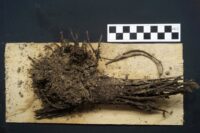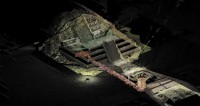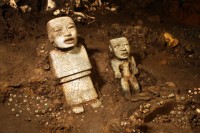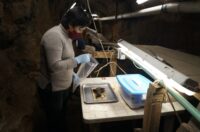 Four intact bouquets of flowers have been discovered in a tunnel under the Temple of the Feathered Serpent in Teotihuacan, Mexico. They were found in excellent condition, preserved with the cotton ropes still tied around the stems. They have not been radiocarbon dated yet, but the timeline of the tunnel’s use and other objects found near the flowers indicate they were deposited in the 1st or 2nd century A.D.
Four intact bouquets of flowers have been discovered in a tunnel under the Temple of the Feathered Serpent in Teotihuacan, Mexico. They were found in excellent condition, preserved with the cotton ropes still tied around the stems. They have not been radiocarbon dated yet, but the timeline of the tunnel’s use and other objects found near the flowers indicate they were deposited in the 1st or 2nd century A.D.
This the first time botanical materials have been found in such an exceptional state of preservation. In addition to the flowers, archaeologists also found maize seeds, beans, chilies, pumpkin seeds and prickly pear seeds. A leaf has been carefully recovered from one of the bouquets and will be studied to identify the plants used.
 The ancient tunnel under the Temple of the Feathered Serpent was first discovered in 2003 when torrential rains opened a sinkhole in front of the temple. The hole led to an underground passage 338 feet long opening into three chambers that had been deliberately filled with soil and rocks and sealed 1,700-1,800 years ago. Archaeologists believe the tunnel symbolized the underworld and the discovery that the ceiling was impregnated with pyrite (to represent the sun/stars) and the ground was covered in large quantities of mercury to simulate water confirmed the cosmological interpretation of the space.
The ancient tunnel under the Temple of the Feathered Serpent was first discovered in 2003 when torrential rains opened a sinkhole in front of the temple. The hole led to an underground passage 338 feet long opening into three chambers that had been deliberately filled with soil and rocks and sealed 1,700-1,800 years ago. Archaeologists believe the tunnel symbolized the underworld and the discovery that the ceiling was impregnated with pyrite (to represent the sun/stars) and the ground was covered in large quantities of mercury to simulate water confirmed the cosmological interpretation of the space.
In 2009, a ground penetrating radar survey mapped out of the length of the tunnel and its attached chambers. Archaeological excavations followed  beginning in 2010. An astonishing array of more than 120,000 artifacts and organic remains have been discovered in the tunnel in the 12 years since the Tlalocan Project began. These offerings were immensely valuable, including imports like jade, amber, rubber, cacao beans, the skins and bones of animals not native to the area like wolves and pumas which came from as far away as Guatemala. The flowers are the climactic final discovery marking the end of the project’s exploration stage.
beginning in 2010. An astonishing array of more than 120,000 artifacts and organic remains have been discovered in the tunnel in the 12 years since the Tlalocan Project began. These offerings were immensely valuable, including imports like jade, amber, rubber, cacao beans, the skins and bones of animals not native to the area like wolves and pumas which came from as far away as Guatemala. The flowers are the climactic final discovery marking the end of the project’s exploration stage.
They were discovered past what was previously believed to be the end of the tunnel. When the team reached the edge, they found that it continued for another 16 feet down a steep descent. In the same area, archaeologists also found pounds of charcoal and charred seeds and fruits from a burnt offering ritual, and a sculpture with unusual characteristics that may been an incense burner.
 The flowers are being cleaned and conserved inside the tunnel to keep them in the humid, cool environment that has preserved them so well for 2,000 years. This is solution is both budget and conservation friendly, as it does not require the creation of a highly controlled environment in a laboratory to prevent rapid deterioration of the organic materials. This is acutely necessary right now as Mexico has had to temporarily close archaeological zones and rebury excavated sites due to lack of resources in the wake of the pandemic.
The flowers are being cleaned and conserved inside the tunnel to keep them in the humid, cool environment that has preserved them so well for 2,000 years. This is solution is both budget and conservation friendly, as it does not require the creation of a highly controlled environment in a laboratory to prevent rapid deterioration of the organic materials. This is acutely necessary right now as Mexico has had to temporarily close archaeological zones and rebury excavated sites due to lack of resources in the wake of the pandemic.
Now that the excavation phase of the tunnel is over, the project’s focus will shift to studying and cataloguing the masses of objects and remains found there.
Is any one else intrigued by the description of the underworld with pyrite stars and mercury rivers and the similarity to the burial chamber under the pyramid of the first emperor of China, Emperor Chin?
Yes, Emily, it does make you wonder.